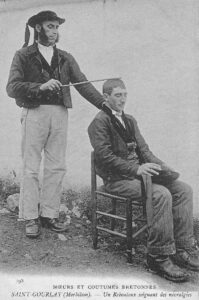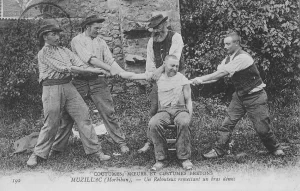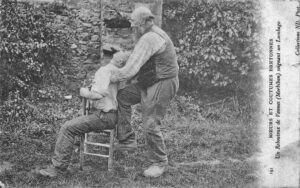In the Brittany (Western France) of yesteryear, there was a dearth of medical doctors practicing in the rural areas and when one could be found, his professional services were rarely affordable. Traditional healing treatments and remedies were therefore widely used; one of the local healers most commonly consulted was the bone-setter.
As the name implies, bonesetters were adept at re-setting broken bones and dealt with all manner of fractures, dislocations and sprains; manipulating bones, joints and muscles to heal the neighbourhood sick at prices that were affordable. The bonesetter would also be consulted on a broader range of issues, such as stomach aches, headaches, heart and circulation problems.
A certain degree of physical strength was needed to be a successful bonesetter and after the Medical reforms enacted in 1803, most had an official primary or secondary occupation to protect them against charges of practicing medicine illegally.
“For broken limbs, strains, sprains, we prefer to go to a bone repairer. In general, they are millers. These people, whose job is to carry very heavy bags of grain, know from father to son how to put bones and muscles back in place. When they do not succeed, you have to get on a charabanc to go to Quimper on a fair day. There, around the Place des Chevaux Gras, outside the walls of the old town, two or three famous bonesetters receive the mutilated in the back rooms of cafes. They never miss a shot.” – Pierre-Jakez Hélias (The Horse of Pride, 1975).
The author and photographer Charles Géniaux described some of his meetings with bonesetters in Upper Brittany in the works La Vieille France (1903) and La Bretagne Vivante (1912) and they provide an interesting insight into the bonesetter’s craft:
“The bonesetter of Saint-Gourlay.. inherited his practice from his mother… wins over the others for two specialties: healing the demented and caring for the heart. The parents of a fool lead him to the bonesetter for treatment. With a wooden stick he hits the sinciput, then the side walls of the skull, until the patient howls. At this moment, he declared that he had found the lesion and, fortified by this result, he showered the unfortunate with plenty of water. Finally the parents will have to apply poultices on the sick part.”

Géniaux also introduced us to a bonesetter named Josso, or as he is usually called, Big Josso. Not only a bonesetter Big Josso is also a gardener and the owner of an inn and would work only for reliable farmers of the region. Usually, the client enters his bar and they start to speak together. The customer complains of his ailment and in this case, he fell from the loft.
Josso proposes to help and both of them go where they are sure that nobody will disturb them. The operation starts, the bonesetter feels the painful area. Most of the time, the bonesetter can operate alone but it can be more complicated: Three or four strong men are called for assistance. Two of them are instructed to pull as mightily as they can while the other prevents the body from moving using a large cloth. At the same time, Big Josso is placing the bone at the right place.

A farmer seeks treatment for kidney pain. Without being moved, the great Josso made him sit astride a chair, and putting his knee on the patient’s spine and grabbing him strongly with his hands criss-crossed across his chest, he twisted backwards, reducing the lumbago by an effort in the opposite direction.

In rural Brittany, bonesetters and other traditional healers filled the void created by the severe lack of medical professionals; they enjoyed the trust and support of the local populace. These were not peripheral figures operating at the margins of society but a key part of that society.
Nevertheless, it was not unusual for the professional medical profession to push for the prosecution of traditional healers such as bonesetters whom they regarded as uneducated and thus dangerous, unfair competition. In earlier times there existed a profound paradox; doctors claimed they could not settle in the countryside because of unfair competition from healers but since there were few doctors, the locals had no alternative but to consult the healers.
In 1951, after pressure from local doctors, a successful bonesetter and miller from Landrévarzec was prosecuted for practicing medicine illegally. A practitioner of some repute, he gave consultations at his mill but also held weekly surgeries in the nearby towns of Douarnenez and Quimper. During his trial, dozens testified on his behalf and reports state that there were up to a thousand protesters outside the courthouse demanding his acquittal. He was found guilty and fined, subsequently being carried by supporters through the city in triumph.
In many countries, these traditional healing practices are regulated but in France, the framework is rather vague. Officially, healers are not allowed to practice and like their predecessors of yesterday, run the risk of being charged with practicing medicine illegally. However, plenty of grey areas exist and there is a significant amount of official toleration. Acupuncture, homeopathy and naturopathy are officially recognised and probably the most frequently consulted types of alternative healing but there are also many other popular non-biomedical practitioners such as magnétiseurs (magnetisers), radiesthésistes (dowsers), iridologists and aromatherapists. Furthermore, it is not uncommon to find a magnétiseur who is also a radiesthésiste or a bonesetter, sometimes re-badged as an osteopath or chiropractor.
Today, over 400 different alternative medical practices are available across France and it has been estimated that as many as four out of ten French people resort to alternative practices, even if only to gain a second opinion after visiting a doctor. While the medical profession may frown upon the continued popularity of practices that might have been expected to drop away with advances in 21st century healthcare, it is perhaps interesting to note that my local Yellow Pages records 580 General Practitioners and 360 bonesetters active today.
References:
Bon Repos Gites. 2022. The bonesetters of Brittany. Accessed online on 30 January 2023 from https://bonjourfrombrittany.wordpress.com/2022/02/13/the-bonesetters-of-brittany/

